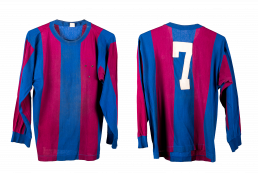Mariano Cuenca wore the number seven on the back of the Levante shirt he ardently defended in the late 1950s. Mariano Cuenca did not run the wing at Vallejo’s home ground. Nor did he put on his studded boots for every game he played in. Nor did he try to bring the ball down to the ground to tame it. Cuenca used his hands to express himself on the surface of the pitch. And he was not a goalkeeper. He was a handball player.
This discipline was part of the imaginary of the azulgrana club. It was one of the sections that made the club unique in the middle part of the last century. Since then, Cuenca has guarded a shirt that symbolises the past of a club with a multidisciplinary vocation. “We had a pass that accredited us as players to the Levante club. With that pass we would go to Vallejo to watch the football team. We were part of Levante”, he recalls with a smile on his lips and an undisguised hint of pride as he does not lose sight of the shirt that he passionately protected for so many days.
“It’s missing the shield, but that has a history,” he says wistfully. And he continues after a short pause. “The shirt had a Velcro fastener that allowed you to put the crest on and take it off when you had to wash it”. It is a relic that he intends to share with all of the Levante supporters. “When there is a physical museum I will donate it. That’s its place”. For the moment, it is part of the catalogue of this virtual version. It is one of the most relevant pieces due to the effect that the passage of time has had on it.
Handball was associated with Levante during the 1940s. Paco Berenguer, president of the entity, ratified this link. Miguel Zabala, an institution in later Spanish handball as a coach, referee or president of the Federation, acted as a link. At that time, handball was the backdrop for the first team’s football matches on the Vallejo pitch. That handball was a far cry from the handball played today. Two teams of eleven players played against each other on a football pitch that was suited to the needs of handball.
Each match consisted of two half-hour halves with a ten-minute interlude. Changes were continuous and unlimited. A football-like system prevailed that emphasised a more attacking interpretation of the game; a goalkeeper, three defenders, two midfielders and five attackers, although the most sought-after players were those who occupied the midfield. At least they were the ones who were strongest at linking the lines. During the 1950s, eleven-a-side handball coexisted with the seven-a-side version, which was beginning to corner the former, although the two competitions never overlapped, as the same players were involved in both varieties.
